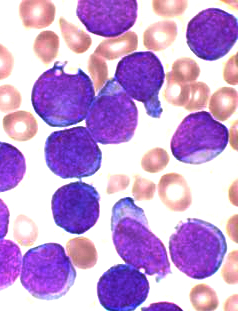FDA Grants Inotuzumab Ozogamicin Breakthrough Status for ALL
The anti-CD22 antibody-drug conjugate inotuzumab ozogamicin has been granted breakthrough therapy designation by the FDA as a potential treatment for relapsed or refractory acute lymphoblastic leukemia patients.

After an open-label phase III trial, the anti-CD22 antibody-drug conjugate inotuzumab ozogamicin has been granted breakthrough therapy designation by the FDA as a potential treatment for relapsed or refractory acute lymphoblastic leukemia (ALL) patients.
“Breakthrough Therapy designation will allow us to work more closely with the FDA to bring this important therapy to patients as rapidly as possible,” Mace Rothenberg, MD, senior vice president of Clinical Development and Medical Affairs and chief medical officer for Pfizer Oncology, the company developing the drug, said in a statement. “Advancing therapies for patients with adult acute lymphoblastic leukemia is crucial as only 10% of adults with ALL who relapse after first-line therapy survive five years or more with current treatment options.”
The phase III trial, which was the cause of the designation, inotuzumab ozogamicin demonstrated a complete response (CR) or CR with incomplete platelet recovery (CRi) rate of 80.7% versus 33.3% with chemotherapy for patients with relapsed or refractory ALL (P<.0001). In those who achieved a CR/CRi, 78.4% were minimal residual disease (MRD)-negative (<0.01% cells by central flow cytometry).
In the study, labeled INO-VATE ALL, 326 patients were enrolled, with the first 218 selected for the primary analysis. One hundred and nine patients received inotuzumab ozogamicin at a starting dose of 1.8 mg/m2each cycle, which consisted of a 0.8 mg/m2dose on day 1 followed by 0.5 mg/m2on day 8 and day 15. In the chemotherapy arm, 109 patients received physicians’ choice of fludarabine plus cytarabine with G-CSF, high-dose cytarabine, or cytarabine plus mitoxantrone.
The study was designed to assess response from the first 218 patients, with overall survival (OS) being analyzed in all 326 individuals. Findings from the first 218 patients were presented at the 20th Congress of the European Hematology Association. At this time, data were still immature for OS. The co-primary endpoints were CR/CRi and OS. Secondary endpoints included duration of remission (DOR), progression-free survival, MRD-negativity in those with CR/CRi, and stem cell transplantation (SCT) rate.
The majority of the patients in the investigational arm were under the age of 55 (61%). The clinical trial represented the first salvage therapy for 67% of patients in the inotuzumab ozogamicin arm versus 63% in the comparator. All patients enrolled in the phase III study were CD22-positive, which is expressed in the majority of patients with B-cell ALL.
For patients who were receiving their first salvage therapy, the CR/CRi rate was 87.7% with inotuzumab ozogamicin versus 31.3% with chemotherapy (P<.0001). In the second salvage therapy setting, the CR/CRi rate with inotuzumab ozogamicin was 66.7% versus 37.9% with chemotherapy (P= .0104). In complete responders, MRD-negativity was achieved in 78.4% versus 28.1%, with inotuzumab ozogamicin and chemotherapy, respectively (P<.0001).
The duration of first complete remission was ≥12 months in 43% of patients treated with inotuzumab ozogamicin compared with 35% in the chemotherapy arm. The median DOR was 4.6 months with inotuzumab ozogamicin compared with 3.1 months for chemotherapy (P= .0169).
Adverse events (AEs) were assessed in 259 patients from the full study population. This analysis consisted of those who received ≥1 dose of inotuzumab ozogamicin (n = 139) or chemotherapy (n = 120). The median duration of treatment in the inotuzumab ozogamicin arm was 8.3 weeks versus 0.9 weeks with chemotherapy.
Eighty-three percent of patients in the inotuzumab ozogamicin arm discontinued treatment over the course of the study versus 89% in the chemotherapy arm. The most common cause of discontinuation in the inotuzumab ozogamicin arm was CR (35%) compared with resistant disease in the chemotherapy arm (40%). The number of patients receiving SCT was doubled in the inotuzumab ozogamicin arm (n = 48) compared with chemotherapy (n = 20).
The most frequently observed grade ≥3 AEs in both arms were hematologic cytopenias. Grade ≥3 hepatobiliary AEs were seen in 9% of patients treated with inotuzumab ozogamicin versus 3% with chemotherapy. All grade veno-occlusive liver disease (VOD) occurred in 15 patients (13 were grade ≥3) in the inotuzumab ozogamicin arm versus 1 in the chemotherapy arm. The majority of VOD cases were seen after SCT (n = 10). In total, there were 2 deaths associated with VOD in the inotuzumab ozogamicin arm.
"The results of a large global phase III study have demonstrated that inotuzumab ozogamicin was superior to standard chemotherapy in patients with relapsed acute lymphoblastic leukemia,” lead investigator Daniel J. DeAngelo, MD, PhD, director of Clinical and Translational Research, Adult Leukemia, Institute Physician at the Dana-Farber Cancer Institute, toldOncLivewhen the data were presented. "Although the analysis is ongoing as we wait for the overall survival data, hopefully this study will translate into improved options for patients with relapsed ALL."
Based on the initial assessment of the trial, Pfizer, the company developing the drug, has entered into discussions with the FDA and other regulatory authorities. The breakthrough designation was designed to help expedite this regulatory process.
Inotuzumab ozogamicin is composed of a humanized IgG4 anti-CD22 antibody covalently linked to N-acetyl-gamma-calicheamicin dimethyl hydrazide (CalichDMH). Upon binding to B cell-specific CD22 receptors, the drug is internalized causing the release of CalichDMH within the cell. The cytotoxic agent CalichDMH causes double-strand DNA breaks and apoptosis.
Clinical trials continue to assess inotuzumab ozogamicin as a treatment for patients with hematologic malignancies. A phase I/II study is looking at the drug as a treatment for elderly patients with ALL (NCT01371630). Additionally, another phase I/II study is exploring the agent in patients with CD22-positive lymphoid malignancies (NCT01664910).
DeAngelo DJ, Stelljes M, Martinelli G, et al. Efficacy and safety of inotuzumab ozogamicin (InO) vs standard of care (SOC) in salvage 1 or 2 patients with acute lymphoblastic leukemia (ALL): an ongoing global phase 3 study. Presented at: 20th Congress of the European Hematology Association (EHA); Sunday, June 14, 2015; Vienna, Austria. Abstract #LB2073.